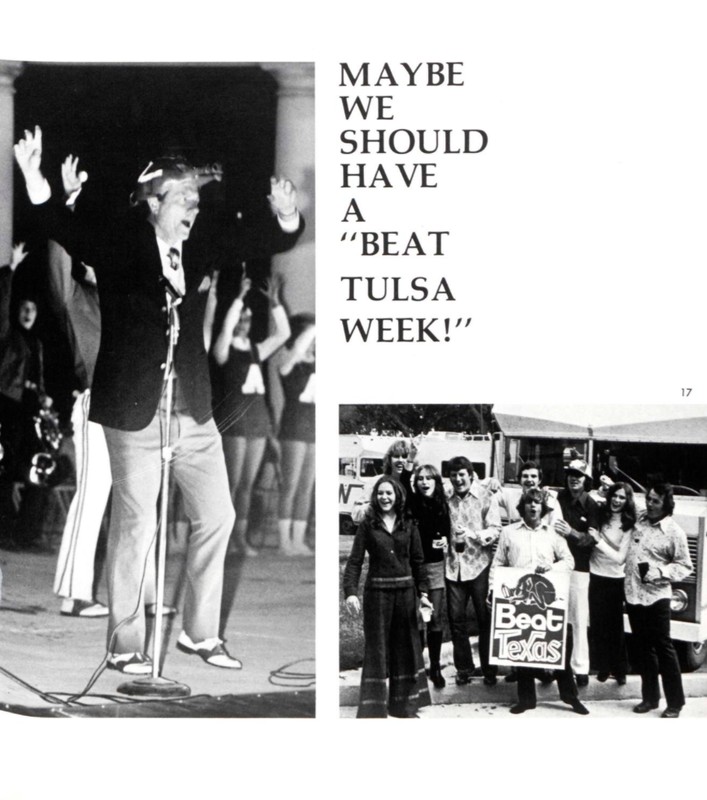Tradition and Terror: Two Different Perspectives on "Beat Texas Week"
Introduction
Text-to-speech Audio
Images

Backstory and Context
Text-to-speech Audio
While African American students at the University of Arkansas have never been immune to racial prejudices and injustices, history demonstrates that some moments are especially trying. With #BlackatUARK’s and the Black Lives Matter movement’s increased visibility, one could argue that the present day represents one of these especially trying moments. Throughout the 1970s, “Beat Texas” week was a trying moment that was renewed annually. Beginning with the infamous 1969 Arkansas vs. Texas game, attended by President Richard Nixon and dubbed the “Game of the Century,” Bad Times contributing writer Mellonee Carrigan described the annual atmosphere of the week surrounding the anticipated game as one resembling “the Civil War Days” for African Americans students.
Even as African Americans joined and contributed to the success of the Razorback football team in the mid 1960s, African American students continued to feel as if the games were not a welcoming place. They endured the jeers and trash hurled at them by white students sitting above them in the stands before learning to arrive early to save the highest seats—and that was if they were courageous enough to attend in the first place. Others, like B.A.D president Mrs. Dinah G. Gant, avoided games altogether, having “never felt comfortable” in the stadium. Incited by the Razorback’s losing streak against the Longhorns, the week of the annual Arkansas vs. Texas game came to be dreaded by African American students.
In its earliest year, “Beat Texas” week saw the shooting of African American football player Darrell Brown and student protests against the band’s playing of “Dixie.” Brown, the Razorbacks’ first African American player, was shot in the leg as he walked home from a basketball game. In a 1969 Traveler article covering the story, Brown remembered his assaillants shouting lines from “Dixie” and “N----- get off the street” as they drove by. A friend of Brown, Eugene Hunt, said “We don’t feel that a person shot at Darrell Brown but at a Black.” This notion of unfettered and directionless violence is echoed in Mellonee Carrigan’s article on “Beat Texas” week from six years later. She records the kicking of “an innocent Black freshman” by the “rebels”—white students, and she criticizes the administration for allowing such chaos during the week year after year. During pep rallies at the Chi Omega Greek Theater, white students would hoist Confederate flags, sing racist cheers, and torment African American passersby.
Conversely, the University of Arkansas Razorback yearbooks from these years document the “Beat Texas” week that white students experienced. In smiling groups, students hold up signs that read “Beat Texas,” and then coach Frank Broyles is shown leading cheers at the same pep rallies that dissuaded African Americans from attending the games. In the 1973 Razorback, a picture of Broyles is juxtaposed with the message “Maybe We Should Have A ‘Beat Tulsa Week!’” The spread demonstrates the vast gap between the experience of white students and the experience of African American students during this week. While white students celebrated and had fun regardless of whether their team won or lost, African American students, reminded by the example of Darrell Brown, were forced to increase their guard against white peers—the “Confederates” for whom Carrigan wrote “anything…was granted and legalized” during “Beat Texas” week.
Sydney Nichols is a junior Bob & Ruth Shipley Honors College Fellow majoring in art history and creative writing, minoring in Southern studies. From Marion, AR, Sydney is interested in the artistic and literary expressions of the South. Upon graduation, Sydney plans to pursue a graduate degree in contemporary American art and curatorial studies.
Sources
"UofA Black Student Shot After Pep Rally By Unknown Sniper." Arkansas Traveler (Fayetteville) December 8th 1969.1.
Carrigan, Mellonee. "Beat Texas Week Compared to Civil War Days/Black Harassment." BAD Times (Fayetteville) September 24th 1975. 3.
Youngblood, Joshua . Campus in 1969, Part II: Dixie, Nixon, and the “Game of the Century”, 365 McIlroy. December 5th 2019. Accessed November 20th 2020. https://librariesblog.uark.edu/campus-in-1969-part-ii-dixie-nixon-and-the-game-of-the-century/.
Razorback. Fayetteville, AR. 1973.
